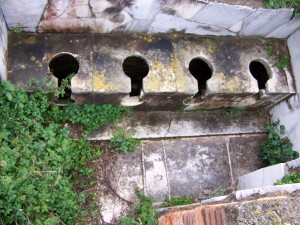Another Tuesday Time Travel…

After spending nearly two weeks visiting ancient Roman sites earlier this year, I was amazed at some of the advances changes in technology the Romans were making in the first and second centuries. One structure that was beginning to become more common was the public latrine. As the following picture reveals, such a structure could seat quite a few people.

You will notice a few features in the picture above:
- Uniform seats similar to today’s toilets (see picture below for an interesting view).
- A trough underneath the seats for ‘flushing’.
- A trench in front of the seats (likely for washing the ‘sponge stick’–see below).
- Remains of marble tiles (indicating the potential expense of a public latrine).
Notice the small trench in front of the seat. One expert on the subject (yes, really!) is classicist Ann Olga Koloski-Ostrow. She (among others) suggests the following purpose for the trench:
Many Roman public toilets, especially the later and more luxurious ones, are equipped with a small trench cut at the foot of the toilet bench. Although the purpose of this trench is still debated, I believe it was used for washing off a sponge that was tied to the end of a short stick and used as toilet paper.*
Well, at least the ‘toilet paper’ received a washing before the next person used it!
Okay…Why study toilets?
Koloski-Ostrow explains:
…We have come to realize how much Roman toilets can teach us. Not only do they embody ideas and attitudes concerning cleanliness, physical health, beauty and privacy, but they also provide essential data about diet and disease.Indeed, the lowly toilet has a much more complex story to tell—that is, one more intimately bound up with daily life—than the most elegant temple or civic building.*
Beyond this, such study of ancient daily life helps us paint an accurate picture of the world in which (and in part, to which) the New Testament was written.
*Koloski-Ostrow, Ann Olga. “Roman Latrines.” Archaeology Odyssey 7, no. 3 (May/June 2004).

[…] on NT backgrounds were listed in the Biblical Studies Carnival XLVI: “Josh Mann flushed the toilet in his first century apartment next to his household idol.” (Please read the articles for […]
thank you for writing this since I doing my homework about romans and I needed something about roman toilets!!!!!I am very interested in this sort of stuff.
Are there any people whose job it was to empty or clean public toilets? I need to know for my homework. Do you know what they were called?
I assume that someone was responsible for supplying the sponge stick, replacing it, and perhaps maintaining the facility. I do not know for certain if this responsibility fell to a particular person whose sole job it was do such things, or whether it may been one of many responsibilities of someone. What you need to do if you can’t find the answer out in sources on the subject is try to contact the woman I mention in the post who specializes in the area and ask her to help you with the question. Don’t only ask her to give you the answer, but ask her to also help point you to a source for your information. Happy researching. Feel free to post back if you get an answer.